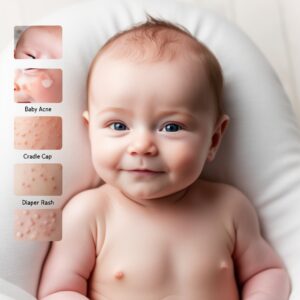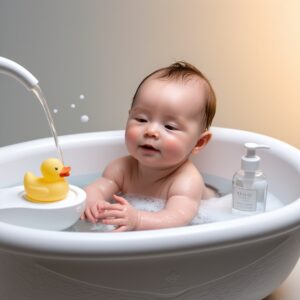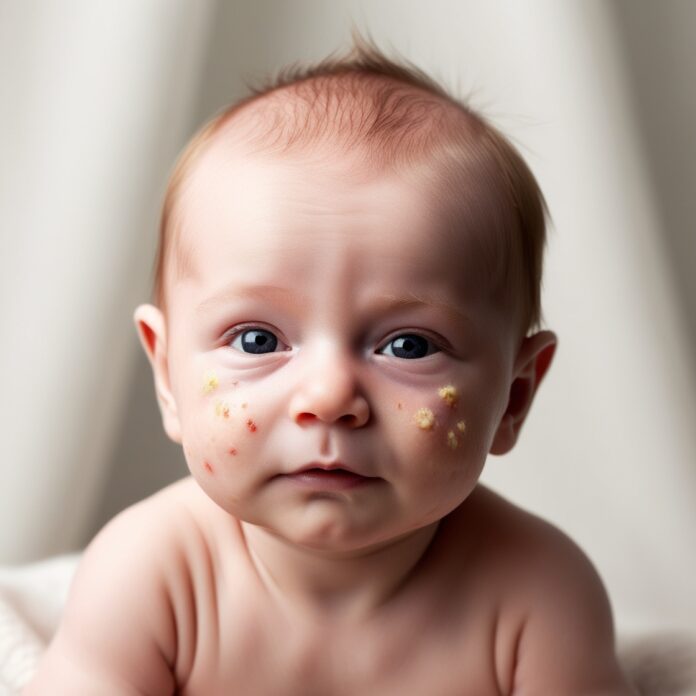As a new parent, one of the first things you will notice is just how fragile your baby’s skin seems. Newborn skin conditions are common; though often concerning in appearance, most of these conditions have no serious harm and may resolve spontaneously. Knowing about these conditions and how to soothe them will offer peace of mind and keep your baby comfortable. This guide covers the most common skin conditions in newborns and provides some tips in soothing and taking care of their sensitive skin.

1. Common Newborn Skin Conditions
Baby Acne
Baby acne is one very common skin condition that usually appears within the first weeks of life. These small, red or white bumps can show up on a baby’s cheeks, nose, and forehead.
- Cause: Probably brought about by the hormonal changes transmitted from mother to baby
- Treatment: Acne in babies typically goes away a few weeks after birth. Cleanse the baby’s skin with mild cleansers prepared for babies. The cradle cap area should not be scrubbed. Application of adult preparations of acne on the newborn should not be done.
Cradle Cap
A baby’s scalp may develop yellowish crusty patches known as cradle cap or seborrheic dermatitis.
- Cause: Believed to be caused by an overproduction of skin oil or a type of yeast called Malassezia.
- Treatment: Gently massage your baby’s scalp with a soft brush and a few drops of baby oil or natural coconut oil. You can also try using a mild baby shampoo to help lift the crusts. In most cases, cradle cap disappears without treatment by 6-12 months.
Diaper Rash
Diaper rash is the most common type of skin irritation found in infants, which results from prolonged exposure to moisture, friction, or irritation, which could be caused by the diapers.
- Cause: More often than not, it is due to a combination of moisture and friction; sometimes, sensitivity to the materials within the diaper and/or wipes exacerbates it further.
- Management: Frequent changing and the application of a barrier cream containing zinc oxide provides a barrier between the skin and the irritant. Another way to lessen irritation is to let the baby’s skin breathe without a diaper for brief periods of time.
Erythema Toxicum
Erythema toxicum: This is an extremely common harmless rash that appears frightening but doesn’t cause discomfort of any kind. It consists of red patches with small white or yellow bumps and usually appears in the first days following birth.
- Cause: The etiology is unknown, despite the fact that the disease is benign.
- Treatment: Erythema toxicum resolves without treatment on its own in one week’s time.
Milia
Milia are tiny, white spots that typically appear on a baby’s chin, cheeks, or nose. These happen when bits of skin get trapped in the hair follicles.
- Cause: Dead skin fragments stuck in small crevices close to the skin’s surface.
- Treatment: Milia often go away on their own. Steer clear of trying to squeeze or scrub them.

2. Less Common Newborn Skin Conditions
Infant Eczema
Eczema: Red, itchy spots on the skin are a symptom of atopic dermatitis. It shows its effects first on the face, arms, or the back of the knees.
- Cause: This condition usually involves genetic and environmental factors that contribute to eczema, often due to irritation, heat, or dryness of the skin.
- Treatment: Moisturize the baby’s skin with hypoallergenic creams. Also, dress the baby with soft and breathable fabrics while avoiding the use of harsh soaps or lotions that irritate the skin.
Heat Rash
Heat rash consists of a cluster of tiny, red bumps that can occur in any fold of the skin or area of the body that is covered by clothing. It can be itchy or uncomfortable.
- Cause: Heavy perspiration caught beneath the skin as a result of usually hot or humid weather conditions.
- Treatment: To keep the infant cool, wear lightweight, loose-fitting clothing. Keeping them away from very hot conditions for long durations will also spare them from contracting heat rash.
3. Caring for Your Newborn’s Skin
The prevention and minimization of common newborn skin conditions can be done by caring for your baby’s skin. Here are practical tips to help protect sensitive skin.
- Use Gentle Cleansers: Opt for mild cleansers that are fragrance-free and hypoallergenic. Avoid soaps containing dyes or other synthetic additives.
- Moisturize Regularly: Apply a gentle, harmless moisturizer on the baby’s skin against dryness. AVOID all products that contain harsh chemicals, especially if the baby suffers from conditions such as eczema.
- Avoid Over-Bathing: Bathing every 2-3 days will be enough for a newborn since frequent baths will take away the natural oils and cause dryness. Use lukewarm water and avoid scrubbing.
- Diaper Area: Frequent change of diapers will reduce the possibility of diaper rash. Before putting on a new diaper, make sure your baby’s skin is completely dry and apply a barrier lotion for protection.

4. When to Consult a Pediatrician
While most skin conditions in the newborn are minor and resolve on their own, some symptoms do warrant a call to your pediatrician. This is worth calling your pediatrician about: .
- Rash not improving or appears to spread: While most rashes in the newborn resolve on their own, if it fails to improve over a few days or appears to spread, it may be infected or another condition altogether.
- Fever or Discomfort: If your baby seems to be unusually uncomfortable, irritable, or develops a fever along with the rash, it will be better to consult a doctor. heading.
- Blisters or Sores: If the skin develops open sores, blisters, or oozing, it is best to seek prompt medical advice to avoid infections.



